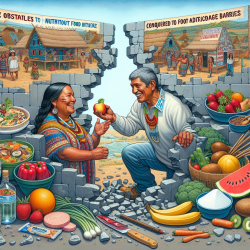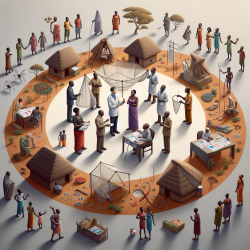Introduction
In the realm of speech-language pathology and therapy services, data-driven decisions are paramount. This blog post explores how practitioners can leverage the findings from the research article "Facilitators and Barriers to Healthy Eating Among American Indian and Alaska Native Adults with Type 2 Diabetes: Stakeholder Perspectives" to enhance their skills and improve outcomes for children and communities. The insights from this research provide valuable guidance for practitioners seeking to culturally adapt nutrition education programs for American Indian and Alaska Native (AI/AN) communities.
Understanding the Research
The research aimed to understand stakeholder perspectives on the facilitators and barriers to healthy eating for AI/AN adults with Type 2 Diabetes (T2D). Through interviews and focus groups with national content experts, community-based key informants, and AI/AN adults with T2D, the study identified three key themes:
- Accommodating diversity across AI/AN communities in diabetes nutrition education programs.
- Building on AI/AN strengths and facilitators to healthy eating, such as strong community support and traditional foods.
- Addressing barriers to healthy eating, including food insecurity and excessive access to processed foods.
Implementing the Findings
For practitioners, implementing these findings can lead to more effective nutrition education programs tailored to the unique needs of AI/AN communities. Here are some actionable steps:
- Embrace Cultural Diversity: Recognize the diversity within AI/AN communities and tailor programs to reflect cultural differences. Incorporate images, motifs, and food references that resonate with specific tribes.
- Leverage Community Strengths: Utilize the strong community and family support systems inherent in AI/AN cultures. Encourage the inclusion of traditional foods and practices in nutrition education.
- Address Barriers: Provide resources and strategies to overcome barriers such as food insecurity and limited access to healthy foods. Educate on affordable cooking and food preparation techniques.
Encouraging Further Research
While this research provides a solid foundation, there is always room for further exploration. Practitioners are encouraged to conduct additional research to deepen their understanding of the unique challenges and strengths within AI/AN communities. Collaborating with local tribes and health organizations can provide valuable insights and foster more effective program development.
Conclusion
By implementing the findings from this research, practitioners can play a crucial role in improving the health outcomes of AI/AN communities. Tailoring nutrition education programs to reflect cultural diversity and leveraging community strengths are key strategies for success. To read the original research paper, please follow this link: Facilitators and Barriers to Healthy Eating Among American Indian and Alaska Native Adults with Type 2 Diabetes: Stakeholder Perspectives.










